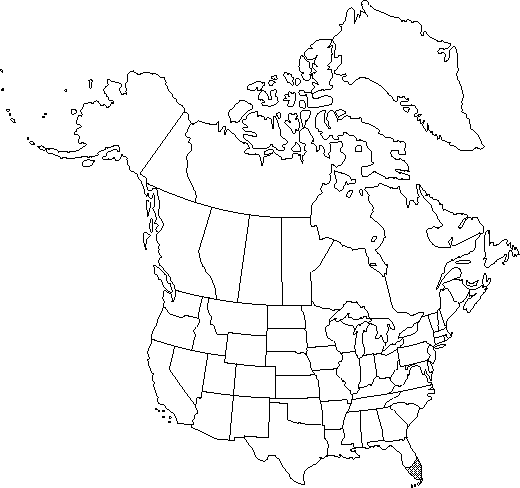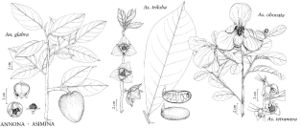Difference between revisions of "Annona glabra"
Sp. Pl. 1: 537. 1753.
imported>Volume Importer |
imported>Volume Importer |
||
| Line 55: | Line 55: | ||
|publication year=1753 | |publication year=1753 | ||
|special status=Illustrated | |special status=Illustrated | ||
| − | |source xml=https:// | + | |source xml=https://bitbucket.org/aafc-mbb/fna-data-curation/src/2e0870ddd59836b60bcf96646a41e87ea5a5943a/coarse_grained_fna_xml/V3/V3_546.xml |
|genus=Annona | |genus=Annona | ||
|species=Annona glabra | |species=Annona glabra | ||
Latest revision as of 21:49, 5 November 2020
Shrubs or trees, to ca. 15 m; trunks commonly buttressed at base. Principal leaves late deciduous; petiole 10-20mm. Leaf blade ovate to elliptic, 5-15 × 6(-8) cm, base broadly cuneate to rounded, apex acute to short-acuminate; surfaces glabrous. Inflorescences from leaf axils on new shoots, solitary flowers; peduncle stout, linear, club-shaped, to 2cm, becoming enlarged. Flowers: sepals reniform-cordate, 5-6 mm, glabrous; outer petals cream-white, ovate-cordate, adaxially concave, 2.5-3 cm, apex acute; inner petals cream-white, inside base deep purple, oblong-ovate, 2-2.5 cm, base cupped, incurved-cuneate, at least 2×3 length of outer petals, corrugate; stamens linear, 3-4 mm; connective thickened above anther tip; pistils conically massed, connate. Syncarp pendulous on thickened peduncle, dull yellow blotched with brown, ± ovoid, 5-12 cm, smooth with reticulate pattern formed by pistil boundaries. Seed ellipsoid to obovoid, 1-1.5 cm. 2n=28.
Phenology: Flowering spring–early summer.
Habitat: Wet substrates, brackish to fresh, in pond borders, tidally influenced stream banks, banks of estuaries and lakes
Elevation: 0-50 m
Distribution

Fla., West Indies, Mexico, Central America, South America, w Africa, South Asia (Sri Lanka).
Discussion
Annona glabra (Annona sect. Phelloxylon Safford) has edible although scarcely desirable, yellow-fleshed fruits. The sectional name (Greek phellos, cork and xylon, wood) is descriptive because small sections of the very light wood have been used as floats by fishermen. Forms with smaller leaves and fruit have been considered a species referable to A. palustris (J. K. Small 1933); W. E. Safford (1914) considered them to be of no taxonomic consequence.
Selected References
None.
